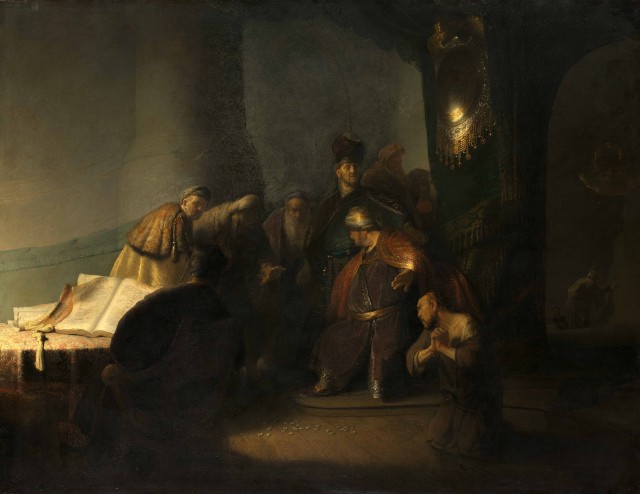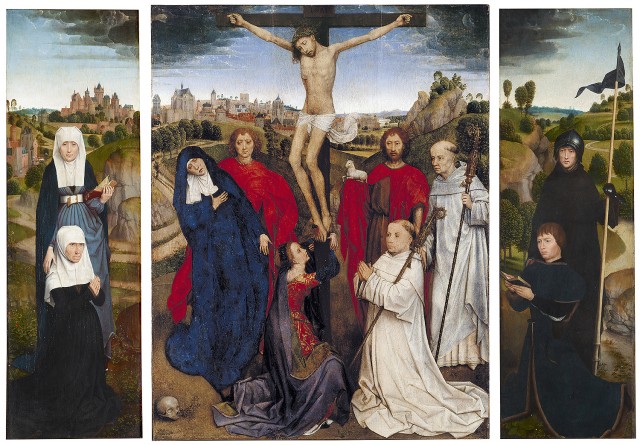
Rembrandt van Rijn, “Judas Returning the Thirty Pieces of Silver,” oil on panel, 1629 (© Private Collection, photo courtesy of the National Gallery, London, 2016)
Morgan Library
225 Madison Ave. at 36th St.
“Rembrandt’s First Masterpiece” through September 18
“Hans Memling: Portraiture, Piety, and a Reunited Altarpiece” through January 8
Tuesday – Sunday, $13-$20 (free Friday nights from 7:00 to 9:00)
212-685-0008
www.themorgan.org
Like the Morgan Library’s spring 2013 exhibition “Degas, Miss La La, and the Cirque Fernando,” an expansive look at Edgar Degas’s thrilling 1879 painting “Miss La La at the Cirque Fernando,” a pair of splendidly curated current shows take viewers deep inside two other remarkable works by two very different artists. Closing on September 18, “Rembrandt’s First Masterpiece” is a thorough examination of Rembrandt van Rijn’s powerful 1629 oil painting “Judas Returning the Thirty Pieces of Silver,” which has never previously been shown in the United States. The canvas depicts the biblical event in which a remorseful Judas Iscariot gives back to the Sanhedrin the reward he received for betraying Jesus. Rembrandt, only twenty-three when he finished the work, displays a masterful use of light and color in relating the narrative, the darkness on the right side and the glowing anachronistic open book on the left flanking a shadowy central section where Judas, hands clasped, begs for forgiveness from suspicious elders. “All this I compare with all the beauty that has been produced throughout the ages. All honor to thee, Rembrandt!” ambassador and diplomat Constantijn Huygens wrote of the work at the time; Huygens’s original manuscript is on view along with other related etchings, drypoints, and ephemera, including rare preparatory drawings for “Judas Returning the Thirty Pieces of Silver,” which have never been seen publicly together with the painting. Also in the show are Rembrandt’s stunning, tiny etching and drypoint “Self-Portrait in Cap, Wide-Eyed and Open-Mouthed,” the etching “Self-Portrait with Curly Hair and White Collar: Bust,” multiple renditions of such biblical scenes as the circumcision of Christ, the presentation in the temple, the crucifixion, and the descent from the cross, and two studies after Leonardo da Vinci’s “The Last Supper,” a theme that Rembrandt never painted, as well as Jan Lievens’s “Portrait of Constantijn Huygens.” It all makes for a fascinating exploration of what is considered Rembrandt’s first mature work.

Hans Memling, “The Triptych of Jan Crabbe,” oil on panel, ca. 1467–70 (center panel: image courtesy of Pinacoteca Civica di Palazzo Chiericati, Vicenza. Left and right panels: © the Morgan Library & Museum, photo by Graham S. Haber)
About 160 years earlier, Flanders-based German painter Hans Memling created “The Triptych of Jan Crabbe,” a dazzling altarpiece that is being seen in full for the first time in more than two centuries. Running through January 8, “Hans Memling: Portraiture, Piety, and a Reunited Altarpiece” packs a whole lot of information into the small Thaw Gallery, comprising the complete triptych, which was commissioned by Cistercian abbot Jan Crabbe around 1470, when Memling was forty, along with other works by Memling and his contemporaries. The inner wings of the altarpiece — one depicting Crabbe’s mother, Anna Willemzoon, with St. Anne, the other pairing his half-brother, Willem de Winter, with St. William — were acquired by J. Pierpont Morgan in 1907 and have been consistently on view in his study ever since. They are now joined by the central panel, in which Crabbe kneels beneath the cross, his hands together, St. John the Baptist and St. Bernard of Clairvaux behind him, the Virgin Mary, St. John the Evangelist, and St. Mary Magdalene on the other side of Jesus on the cross, a foreboding skull in the lower corner. The outer wings, known as the Annunciation Panels, show the Angel Gabriel and Mary. Infrared and X-radiography reveal some of Memling’s working process through images of his underdrawing and various changes he made while painting. The exhibit is supplemented by such other works by Memling as the Frick’s extraordinary “Portrait of a Man” and the Morgan’s “Portrait of a Man with a Pink,” examples of Book of Hours illuminated manuscripts that both influenced and were influenced by Memling, oil paintings and drawings by the Master of the St. Ursula Legend and artists from the Netherlandish school, and an exquisite metalpoint by Gerard David. Perhaps what is most impressive in both the Rembrandt and Memling exhibits are the precise, masterful techniques they utilized in order to bring such striking humanity and emotional depth to the works as a whole as well as to the individual characters, who seem to be alive with breath as they contemplate their fate in the wake of the crucifixion of Jesus. There will be a gallery talk led by Morgan assistant curator Ilona van Tuinen on September 16 (free with museum admission, 6:00), Met curator Maryan Ainsworth will deliver the lecture “A Closer Look at Hans Memling’s Working Methods” on October 4 ($15, 6:30), and the Morgan will host the concert “Flanders Remembers: Music and Words from WWI” on November 17 ($35 including gallery visit, 7:00).